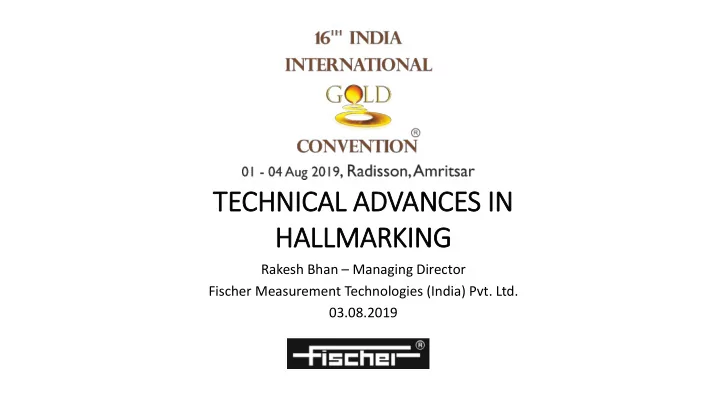

TE TECH CHNICAL AD L ADVAN ANCES S IN HA HALLMAR ARKING Rakesh Bhan – Managing Director Fischer Measurement Technologies (India) Pvt. Ltd. 03.08.2019
Gold ld S Stages a and A Analy lysis is 2
• Various analytical methods • OES • X-ray Fluorescence Analysis (XRF) • Fire Assaying Ultrasonic • Etc. • Methods giving macro structural information • Ultrasonic Transmission and Resonant Ultrasound Spectroscopy (RUS) Gold • Eddy-current analysis (EC) Inspection • Etc. Analytical integrity, composition Eddy-current OES/XRF/Fire Assay 3
Bene nefits o of EDXR XRF T F Techn hniqu que Fast, Quick, Accurate and Non Destructive Requires no or very less sample preperation Measurement is done directly on solid sample and does not rely on acid digestion Quantitative Analysis of gold alloys including Platinum Group Metals (Pt, Pd, Rh, Ru, Ir, Os) Easy to use and practically feasible Quantification of all metals of interest in one single measurement. Advances in detection sensitivity has improved precision and accuracy of the measurement comparable to fire assay method. 4
Major C Components o of an E EDXRF X-Ra Ray t tube ube: Micro Focus tube with Beryllium Window Pr Prim imary Fi Filt lter: Camer era: Fixed or Multiple Changeable High Resolution CCD Camera Filters like Nickel, Aluminum , Mylar etc. Colli llimator: Fixed or Motorised Changeable SDD D Detec ector / S Si P PIN N Detec ector/PC : Collimators like - Resolutions : 140eV/ 180eV/ 800eV Ø 0.2 mm (7.9 mils), Ø 0,6 mm (23.6 mils), Ø 1 mm (39.4 mils), Ø 3 mm (118 mils) others on request 5
Mea easurem emen ent – Effec ects a and nd Inter erferenc nces es 6
Fact ctors Af Affect cting Ac g Accuracy cy and Reproduci cibility of of XRF M Mea easurem emen ents Instrument Factors: External Factors: Resolution of the Detector Sample Homogeneity Collimator Environmental Conditions Measuring distance Positioning of the Sample Measuring time Focusing Calibration Operator Skill Measurement Approach 7
Sp Spec ectrum – Prop oportional C al Cou ounter T Tube Wider spectrums with overlaps due to High Energy Resolution Measuring Parameters Material Composition as detected by the XRF Counts per second as Instrument detected by the Measurement time for detector which the sample was exposed to X-Ray 8
Sp Spec ectrum – Si PIN / / SDD De DD Detec ector or Unique spectrums for individual elements due to low Energy Resolution Measuring Parameters Counts per second as detected by the detector Material Composition as detected by the XRF Measurement time for which Instrument the sample was exposed to X- Ray Time for which a detector is unable to detect another photon when a photon is being detected 9
SDD De DD Detec ector or Better sensitivity at low energies Al peak for PIN (blue) and SDD (grey) 10
New I Impr provemen ents i in n Detec ector T Techno hnology Existing Setup New Setup 20/30 mm 2 SDD + Function (SuperSense) SDD + old DPP electronics DPP: DPP+ Max. energy < 165 eV < 140 eV resolution Fe 55 Time to peak 1.6 µs 0.4 µs Top width 0.4 µs 0.125 µs 350.000 Count rate in cps up to 100.000 up to 500.000 300.000 • Diagnostic features Bus Errors Tracking power Recorded count rate [cps] 250.000 supply • voltages and 200.000 currents 150.000 • BIAS voltage • cooler current 100.000 • detector 50.000 temperature • HT operation 0 0 1.000.000 2.000.000 3.000.000 4.000.000 5.000.000 True count rate [cps] 11
Measu asurement S Spot ot S Size X-ray tube = ⋅ + + ⋅ M c ( d 0 d 1 ) / d 0 s 0 d 1 / d 0 The size of the measurement spot depends on size of collimator c, focal spot of the anode s0 ratio d0/d1. Small Measurement spot allows for the best determination of inhomogeneity's Large Measurement spot allows for low influence of inhomogeneity Sample 12
Adv dvanc nced O ed Optical Co Collimati tion S n Systems mono capillary poly capillary mirror optics spot size [ µ m] 100 – 300 ~ 10 - 60 20 x 50 ~ 10 ~ 500 ~ 10 amplification 13
Measu asuring D Distan ance ce - Md Md Automatic correction of the reading Any md in the valid calibrated range can be chosen Signal (count rate) ~ 1 / (measuring distance) 2 repeatability ~ √count rate → keep measuring distance small! 14
Measu asuring T Time Repeatability: s ~ √measuring time Four times longer measuring time will improve the repeatability by a factor of 2. Sometimes very long measuring time will not further improve the standard deviation. It is better to utilise the mean value of several measurements With advances in signal processing electronics, very accaurate results can be obtained with a measuring time of 30 mins. 15
Calib libratio tion To ensure valid results, measuring equipment shall be calibrated against measurement standards traceable to international or national measurement standards. Ensures Traceability of measurement results Helps to minimize the Systematic Error Integrity of the calibration standards is very important 16
Automatio tion a and D Data Integrity ity Enterprise Level MES MES Level SCADA Operator Level PLC ERP Controller Level Field Level 17
Thank You for Your Attention! Rakesh Bhan Fischer Measurement Tech. India Pvt. Ltd. Plot No.138/1, City Centre, Hinjewadi Phase 1, Pune +91 9766309851 rakesh@fischerindia.com 18
Recommend
More recommend